Effects of Water, Fertilizer and Heat Coupling on Soil Hydrothermal Conditions and Yield and Quality of Annona squamosa
Abstract
:1. Introduction
2. Materials and Methods
2.1. Overview of the Experimental Area
2.2. Experiment Design
2.3. Measurments
2.4. Methods
3. Statistical Analysis
4. Results
4.1. Effects of Water, Fertilizer and Heat Coupling on Soil Hydrothermal Properties
4.1.1. Effects of Different Treatments on Soil Moisture Content
4.1.2. Effects of Different Treatments on Soil Temperature
4.2. Effects of Water, Fertilizer and Heat Coupling on the Growth Indicators of A. squamosa
4.3. Effects of Water, Fertilizer and Heat Coupling on Yield and Quality of A. squamosa
4.4. The Correlation between Yield and Quality of A. squamosa under Water, Fertilizer and Heat Coupling
5. Discussion
5.1. Effects of Water, Fertilizer and Heat Coupling on Soil Hydrothermal Properties
5.2. Effects of Water, Fertilizer and Heat Coupling on the Growth Indicators of A. squamosa
5.3. Effects of Water, Fertilizer and Heat Coupling on Yield and Quality of A. squamosa
6. Conclusions
Author Contributions
Funding
Data Availability Statement
Conflicts of Interest
References
- Barbosa, M.R.; de Araujo Silva, M.M.; Willadino, L.; Ulisses, C.; Camara, T.R. Plant generation and enzymatic detoxifi cation of reactive oxygen species. Cienc. Rural 2014, 44, 453–460. [Google Scholar] [CrossRef]
- Zhang, K.; Chen, K.; Li, W.; Qiao, H.; Zhang, J.; Liu, F.; Fang, Y.; Wang, H. Effects of Irrigation Amount on Berry Development and Aroma Components Accumulation of Shine Muscat Grape in Root-Restricted Cultivation. Sci. Agric. Sin. 2023, 56, 129–143. [Google Scholar]
- Gao, R.; Pan, Z.; Zhang, J.; Chen, X.; Qi, Y.; Zhang, Z.; Chen, S.; Jiang, K.; Ma, S.; Wang, J.; et al. Optimal cooperative application solutions of irrigation and nitrogen fertilization for high crop yield and friendly environment in the semi-arid region of North China. Agric. Water Manag. 2023, 283, 108326. [Google Scholar] [CrossRef]
- Fan, J.; Lu, X.; Gu, S.; Guo, X. Improving nutrient and water use efficiencies using water-drip irrigation and fertilization technology in Northeast China. Agric. Water Manag. 2020, 241, 106352. [Google Scholar] [CrossRef]
- Punetha, A.; Kumar, D.; Chauhan, A.; Suryavanshi, P.; Padalia, R.C.; Upadhyay, R.K.; Venkatesha, K.T. Soil moisture stress induced changes in essential oil content and bioactive compounds in German chamomile (Chamomilla recutita L.). J. Essent. Oil Res. 2023, 35, 289–295. [Google Scholar] [CrossRef]
- Opazo, I.; Pimentel, P.; Salvatierra, A.; Ortiz, M.; Toro, G.; Garrido-Salinas, M. Water stress tolerance is coordinated with water use capacity and growth under water deficit across six fruit tree species. Irrig. Sci. 2024, 42, 493–507. [Google Scholar] [CrossRef]
- Li, C.; Wang, J.G.; Zhang, Y.X.; Feng, H.; Zhang, W.X.; Siddique, K.H.M. Response of plastic film mulched maize to soil and atmospheric water stresses in an arid irrigation area. Eur. J. Agron. 2024, 154, 127080. [Google Scholar] [CrossRef]
- Alomari-Mheidat, M.; Corell, M.; Martín-Palomo, M.J.; Castro-Valdecantos, P.; Medina-Zurita, N.; de Sosa, L.L.; Moriana, A. Moderate Water Stress Impact on Yield Components of Greenhouse Tomatoes in Relation to Plant Water Status. Plants 2024, 13, 128. [Google Scholar] [CrossRef]
- Zhong, T.; Zhang, J.X.; Du, L.L.; Ding, L.; Zhang, R.; Liu, X.R.; Ren, F.F.; Yin, M.; Yang, R.H.; Tian, P.L.; et al. Comprehensive evaluation of the water-fertilizer coupling effects on pumpkin under different irrigation volumes. Front. Plant Sci. 2024, 15, 1386109. [Google Scholar] [CrossRef]
- Zhang, K.; Wei, H.Y.; Chai, Q.; Li, L.L.; Wang, Y.; Sun, J. Biological soil conditioner with reduced rates of chemical fertilization improves soil functionality and enhances rice production in vegetable-rice rotation. Appl. Soil Ecol. 2024, 195, 105242. [Google Scholar] [CrossRef]
- Cui, C.C.; Song, J.Q.; Han, S.X.; Wang, J.C.; Ji, G.X.; Zhang, Z.; Zhang, H.J.; Zhiying, E.; Yuan, Y.; Zhang, H.H. The effect of nitrogen reduction combined with biochar application on the photosynthetic function of tobacco leaves. J. Plant Interact. 2024, 19, 2369759. [Google Scholar] [CrossRef]
- Ikazaki, K.; Nagumo, F.; Simpore, S.; Barro, A. Understanding yield-limiting factors for sorghum in semi-arid sub-Saharan Africa: Beyond soil nutrient deficiency. Soil Sci. Plant Nutr. 2024, 70, 114–122. [Google Scholar] [CrossRef]
- Cui, J.; Ren, J.; Li, Z.; Feng, X.; Zhang, X.; Yan, Y.; Geng, Z. Effects of water and fertilizer coupling on growth, fruit yield and quality and soil nutrient characteristics of apple saplings. Int. J. Fruit Sci. 2023, 40, 2098–2111. [Google Scholar]
- Zhou, X.; Lu, T.; Xing, M.; Song, R.; Fu, X. Effects of water and fertilizer coupling on growth physiology and yield of Jun jujube under drip irrigation in Southern Xinjiang. J. Huazhong Agric. Univ. 2023, 42, 195–205. [Google Scholar]
- Wang, X.J.; Tian, L.; Wang, T.L.; Zhang, E.H. Replacing nitrogen in mineral fertilizers with nitrogen in maize straw increases soil water-holding capacity. Sci. Rep. 2024, 14, 9337. [Google Scholar] [CrossRef] [PubMed]
- Wang, G.; Duan, Y.; Liu, Z.; Wang, N.; Gao, Y.; Li, Y.; Wang, W.; Cai, S.; Sun, L. Effects of Soil Hydrothermal Response and Pools of Carbon and Nitrogen Under Straw Cover Rotation on Slope Farmland of Low Mountains and Hills. Acta Pedol. Sin. 2023, 60, 1058–1066. [Google Scholar]
- Li, M.X.; Ali, S.; Hussain, S.A.; Khan, A.; Chen, Y. Diverse tillage practices with straw mulched management strategies to improve water use efficiency and maize productivity under a dryland farming system. Heliyon 2024, 10, e29839. [Google Scholar] [CrossRef]
- Wang, F.; Guo, S.; Liao, Y.; Ma, Y. Effects of grass mulching-fertilization mode on leaf functional characters and fruit yield as well as quality of Castanea mollissima. J. Beijing For. Univ. 2022, 44, 36–46. [Google Scholar]
- Wang, Z.; Yang, M.; Yang, Y.; Li, X.; Huang, Y.; Lin, J.; Jiang, F.; Zhang, Y. Effects of Terrace and Grass Growing Measures on Soil Nutrients of Slope Orchards in Red Soil Hilly Region. Chin. J. Soil Sci. 2024, 55, 412–419. [Google Scholar]
- Shen, L.; Wang, F.; Liu, Y.; Cai, M.; Luo, F.; Zhong, S.; Mu, L.; Huang, B. Research progress of white clover forage cultivation technsiques based on bibliometrics. Pratacultural Sci. 2023, 40, 1027–1038. [Google Scholar]
- Cheng, Z.; Fan, X.; Xia, Y.; Liu, D.; Tan, Y.; Yan, C.; Fan, D.; Liao, G.; Hu, L. Combined effects of living mulch and fertilizer reduction on nitrogen and phosphorus runoff loss in a citrus orchard. J. Agric. Resour. Environ. 2023, 40, 1358–1367. [Google Scholar]
- Feng, F.X.; Huang, G.B.; Chai, Q.; Yu, A.Z. Tillage and Straw Management Impacts on Soil Properties, Root Growth, and Grain Yield of Winter Wheat in Northwestern China. Crop Sci. 2010, 50, 1465–1473. [Google Scholar] [CrossRef]
- Tu, A.; Xie, S.; Zheng, H.; Li, H.; Li, Y.; Mo, M. Long-term effects of living grass mulching on soil and water conservation and fruit yield of citrus orchard in south China. Agric. Water Manag. 2021, 252, 106897. [Google Scholar] [CrossRef]
- Fan, J.; Gao, Y.; Wang, Q.; Malhi, S.S.; Li, Y. Mulching effects on water storage in soil and its depletion by alfalfa in the Loess Plateau of northwestern China. Agric. Water Manag. 2014, 138, 10–16. [Google Scholar] [CrossRef]
- Qin, W.; Hu, C.; Oenema, O. Soil mulching significantly enhances yields and water and nitrogen use efficiencies of maize and wheat: A meta-analysis. Sci. Rep. 2015, 5, 16210. [Google Scholar] [CrossRef] [PubMed]
- Sun, H.-X.; Wang, W.; Zhang, P.; Wang, Z.-W.; Jia, Z.-K.; Yang, B.-P.; Han, Q.-F. Effects of straw mulching on soil moisture and watermelon yield in dryland. Ying Yong Sheng Tai Xue Bao = J. Appl. Ecol. 2014, 25, 2004–2010. [Google Scholar]
- Li, W.; Wang, L.; Ma, J.; Wang, Z. Effects of a cover crop on deep soil water and root characteristics in a dryland apple orchard on the Loess Plateau. Acta Prataculturae Sin. 2023, 32, 63–74. [Google Scholar]
- Sun, W.; Liu, X.; Dong, T.; Yin, X.; Niu, J.; Ma, M. Root distribution, soil characteristics, root distribution and fruit quality affected by different mulching measures in apple orchard in the dry area of eastern Gansu. Int. J. Fruit Sci. 2015, 32, 841–851. [Google Scholar]
- Liu, X.; Li, H.; Li, J.; Wang, W.; Zhao, M.; Sun, D. The effects of different mulching way on soil water thermal characteristics in pear orchard in the arid area. Acta Ecol. Sin. 2014, 34, 746–754. [Google Scholar]
- Wang, P.; Liu, J.-H.; Xia, R.-X.; Wu, Q.-S.; Wang, M.-Y.; Dong, T. Arbuscular mycorrhizal development, glomalin-related soil protein (GRSP) content, and rhizospheric phosphatase activitiy in citrus orchards under different types of soil management. J. Plant Nutr. Soil Sci. 2011, 174, 65–72. [Google Scholar] [CrossRef]
- Li, Y.; Wang, C.; Tan, F.; Han, L.; Qian, Y.; Zhao, X. Impacts Report of Winter Meteorological Conditions on Agricultural Production in 2022/2023. Chin. J. Agrometeorol. 2023, 44, 535–537. [Google Scholar]
- Huangfu, X.; Li, Y.; Xie, Z. Regulation and regulation mechanism of internode growth of new shoots in fruit trees. Plant Physiol. J. 2024, 60, 284–294. [Google Scholar]
- Liu, Z.; Jin, G. Bias Analysis of Seasonal Changes of Leaf Area Index Derived from Optical Methods. Sci. Silvae Sin. 2016, 52, 11–21. [Google Scholar]
- Zhang, Y.; Zhang, Y.; Li, N.; Guo, Z.; Li, D. Development and application of comprehensive evaluation system for blood orange fruit quality. J. Fruit Sci. 2022, 39, 302–310. [Google Scholar]
- Ranganna, S.; Govindarajan, V.S.; Ramana, K.V. Citrus fruits. Part II. Chemistry, technology, and quality evaluation. B. Technology. Crit. Rev. Food Sci. Nutr. 1983, 19, 1–98. [Google Scholar] [CrossRef]
- Navarro, J.M.; Flores, P.; Garrido, C.; Martinez, V. Changes in the contents of antioxidant compounds in pepper fruits at different ripening stages, as affected by salinity. Food Chem. 2006, 96, 66–73. [Google Scholar] [CrossRef]
- Yu, S.; Yu, Y.; Zhao, F.; Huang, S. Spectrophotometric Determination for Vitamin C in the Tubers and Fruit. Guangdong Trace Elem. Sci. 2005, 12, 41–43. [Google Scholar]
- Lu, X.; Li, Z.; Sun, Z.; Bu, Q. Straw Mulching Reduces Maize Yield, Water, and Nitrogen Use in Northeastern China. Agron. J. 2015, 107, 406–414. [Google Scholar] [CrossRef]
- Medrano, H.; Tomas, M.; Martorell, S.; Escalona, J.-M.; Pou, A.; Fuentes, S.; Flexas, J.; Bota, J. Improving water use efficiency of vineyards in semi-arid regions. A review. Agron. Sustain. Dev. 2015, 35, 499–517. [Google Scholar] [CrossRef]
- Zhu, H.; Liu, L.; Fei, L. Effects of drip irrigation water temperature on soil infiltration and soil temperature. J. Drain. Irrig. Mach. Eng. 2019, 37, 902–908. [Google Scholar]
- Zhou, Q.; Chen, J.; Shi, C.; Xing, Y.; Ma, S.; Zhang, X.; Wang, L. Effects of Chinese milk vetch intercropping with rapeseed under straw mulching on soil microenvironment. Agric. Res. Arid. Areas 2019, 37, 193–199. [Google Scholar]
- Namaghi, M.N.; Davarynejad, G.H.; Ansary, H.; Nemati, H.; Feyzabady, A.Z. Effects of mulching on soil temperature and moisture variations, leaf nutrient status, growth and yield of pistachio trees (Pistacia vera.L). Sci. Hortic. 2018, 241, 115–123. [Google Scholar] [CrossRef]
- Jodaugiene, D.; Pupaliene, R.; Marcinkeviciene, A.; Sinkeviciene, A.; Bajoriene, K. Integated Evaluation on The Effect of Organic Mulches and Different Mulch Layer on Agrocenosis. Acta Sci. Pol.-Hortorum Cultus 2012, 11, 71–81. [Google Scholar]
- Liu, Z.; Wang, Y.; Yu, Z.; Li, X.; Luo, D. Study on Film Drip Irrigation of Maize to Dynamic Changes of Soil Temperature. In Proceedings of the International Symposium on Material, Energy and Environment Engineering (ISM3E), Changsha, China, 28–29 November 2015; pp. 129–133. [Google Scholar]
- Yang, P.; Li, J.; Yan, B.; Niu, J. Effects of applied nitrogen on dry matter accumulation and oil flax yield in flax/soybean intercropping system. Chin. J. Oil Crop Sci. 2015, 37, 489–497. [Google Scholar]
- Yang, X.; Wei, J.; Zhang, Z.; Tian, H. Dynamic Change of Dry Matter Accumulation and Distribution of Winter Wheat under Different Distance to Drip Tape. Acta Agric. Boreali-Occident. Sin. 2012, 21, 72–76. [Google Scholar]
- Wu, B.; Yang, P.; Zuo, W.; Zhang, W. Optimizing water and nitrogen management can enhance nitrogen heterogeneity and stimulate root foraging. Field Crop. Res. 2023, 304, 109183. [Google Scholar] [CrossRef]
- Pendergast, L.; Bhattarai, S.P.; Midmore, D.J. Benefits of oxygation of subsurface drip-irrigation water for cotton in a Vertosol. Crop Pasture Sci. 2013, 64, 1171–1181. [Google Scholar] [CrossRef]
- Pezeshki, S.R. Wetland plant responses to soil flooding. Environ. Exp. Bot. 2001, 46, 299–312. [Google Scholar] [CrossRef]
- Shi, C.; Guo, Y.; Zhu, J. Evaluation of over fertilization in China and its influencing factors. Res. Agric. Mod. 2016, 37, 671–679. [Google Scholar]
- Elia, A.; Conversa, G. Agronomic and physiological responses of a tomato crop to nitrogen input. Eur. J. Agron. 2012, 40, 64–74. [Google Scholar] [CrossRef]
- Li, S.-X.; Wang, Z.-H.; Malhi, S.S.; Li, S.-Q.; Gao, Y.-J.; Tian, X.-H. Nutrient and Water Mangement Effects on Crpo Production, and Nutrient and Water Use Efficiebcy in Dryland Areas of China. Adv. Agron. 2009, 102, 223–265. [Google Scholar]
- Hu, W.; Ren, T.; Meng, F.; Cong, R.; Li, X.; White, P.J.; Lu, J. Leaf photosynthetic capacity is regulated by the interaction of nitrogen and potassium through coordination of CO2 diffusion and carboxylation. Physiol. Plant. 2019, 167, 418–432. [Google Scholar] [CrossRef] [PubMed]
- Cao, X.; An, G.; Zhang, Z. Influence of Different Mulchings on Soil Nutrients, Enzyme Activity and Tree Growth in Non-irrigation Apple Orchard. Acta Agric. Boreali-Occident. Sin. 2016, 25, 788–794. [Google Scholar]
- Dong, S.; Wan, S.; Kang, Y.; Miao, J.; Li, X. Different mulching materials influence the reclamation of saline soil and growth of the Lycium barbarum L. under drip-irrigation in saline wasteland in northwest China. Agric. Water Manag. 2021, 247, 106730. [Google Scholar] [CrossRef]
- Chen, S.Y.; Zhang, X.Y.; Pei, D.; Sun, H.Y.; Chen, S.L. Effects of straw mulching on soil temperature, evaporation and yield of winter wheat: Field experiments on the North China Plain. Ann. Appl. Biol. 2007, 150, 261–268. [Google Scholar] [CrossRef]
- Sun, M.; Ju, H.; Jiang, H.; Yuan, W.; Zhou, H. Research progress of nondestructive detection technology in fruit maturity. Food Ferment. Ind. 2023, 49, 354–362. [Google Scholar]
- Wei, X.; Bi, H.; Liang, W.; Hou, G.; Kong, L.; Zhou, Q. Relationship between Soil Characteristics and Stand Structure of Robinia pseudoacacia L. and Pinus tabulaeformis Carr. Mixed Plantations in the Caijiachuan Watershed: An Application of Structural Equation Modeling. Forests 2018, 9, 124. [Google Scholar] [CrossRef]
- Perez-Pastor, A.; Ruiz-Sanchez, M.C.; Martinez, J.A.; Nortes, P.A.; Artes, F.; Domingo, R. Effect of deficit irrigation on apricot fruit quality at harvest and during storage. J. Sci. Food Agric. 2007, 87, 2409–2415. [Google Scholar] [CrossRef]
- Savci, S. Investigation of Effect of Chemical Fertilizers on Environment. In Proceedings of the 3rd International Conference on Environmental Science and Development (ICESD), Hong Kong, China, 5–7 January 2012; pp. 287–292. [Google Scholar]
- Mei, S.; Zhu, H.; Wang, S.; Yang, X. Effects of Different Mulching Methods on Soil Moisture, Nutrient, Temperature Status and Corn Yield. J. Irrig. Drainage Eng-ASCE 2020, 39, 68–73. [Google Scholar]
- Munoz, A.E.; Weaver, R.W. Competition between subterranean clover and rygrass for uptake of 15N-labeled fertilizer. Plant Soil 1999, 211, 173–178. [Google Scholar] [CrossRef]
- TerAvest, D.; Smith, J.L.; Carpenter-Boggs, L.; Hoagland, L.; Granatstein, D.; Reganold, J.P. Influence of Orchard Floor Management and Compost Application Timing on Nitrogen Partitioning in Apple Trees. Hortscience 2010, 45, 637–642. [Google Scholar] [CrossRef]
- Zhong, Y.; Fei, L.; Li, Y.; Zeng, J.; Dai, Z. Response of fruit yield, fruit quality, and water use efficiency to water deficits for apple trees under surge-root irrigation in the Loess Plateau of China. Agric. Water Manag. 2019, 222, 221–230. [Google Scholar] [CrossRef]
- Xie, J.-y.; Wang, Z.-h.; Li, S.-x.; Tian, X.-h. Effects of Different Surface Mulching on Soil Organic Nitrogen Accumulation and Mineralization in Dryland of Northwestern China. Sci. Agric. Sin. 2010, 43, 507–513. [Google Scholar]
- Navarro, J.M.; Botía, P.; Pérez-Pérez, J.G. Influence of deficit irrigation timing on the fruit quality of grapefruit (Citrus paradisi Mac.). Food Chem. 2015, 175, 329–336. [Google Scholar] [CrossRef] [PubMed]
- Wang, W.; Liu, X.; Cheng, C.; Xie, X.; Li, L.; Bai, J.; Liu, P.; Zhong, C.; Li, D. Effects of salt and drought stresses and light quality on vitamin C content and expression of synthetic genes in kiwifruit leaves. Int. J. Fruit Sci. 2022, 39, 203–210. [Google Scholar]
- Morales-Olmedo, M.; Ortiz, M.; Selles, G. Effects of transient soil waterlogging and its importance for rootstock selection. Chil. J. Agric. Res. 2015, 75, 45–56. [Google Scholar] [CrossRef]
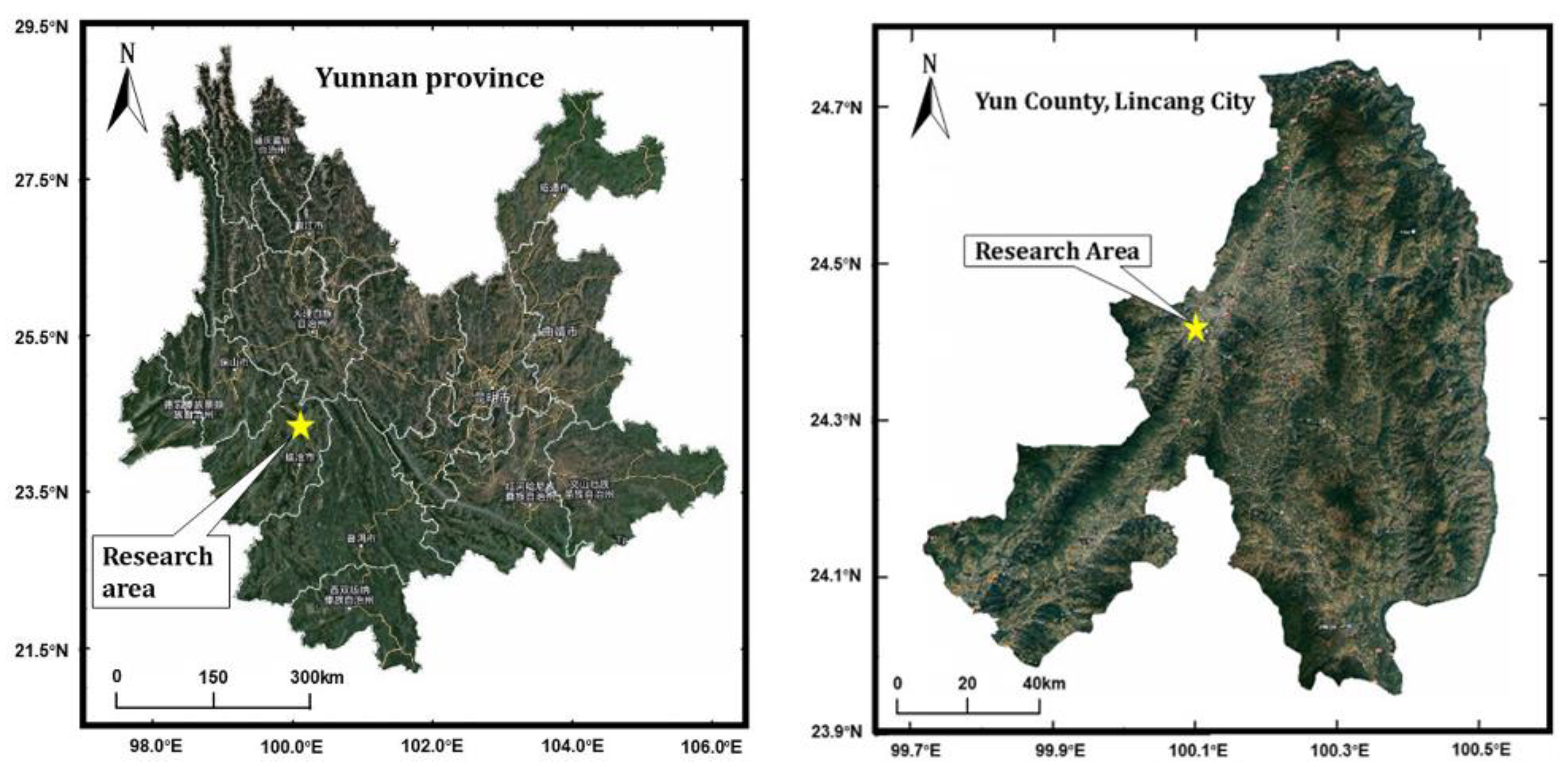

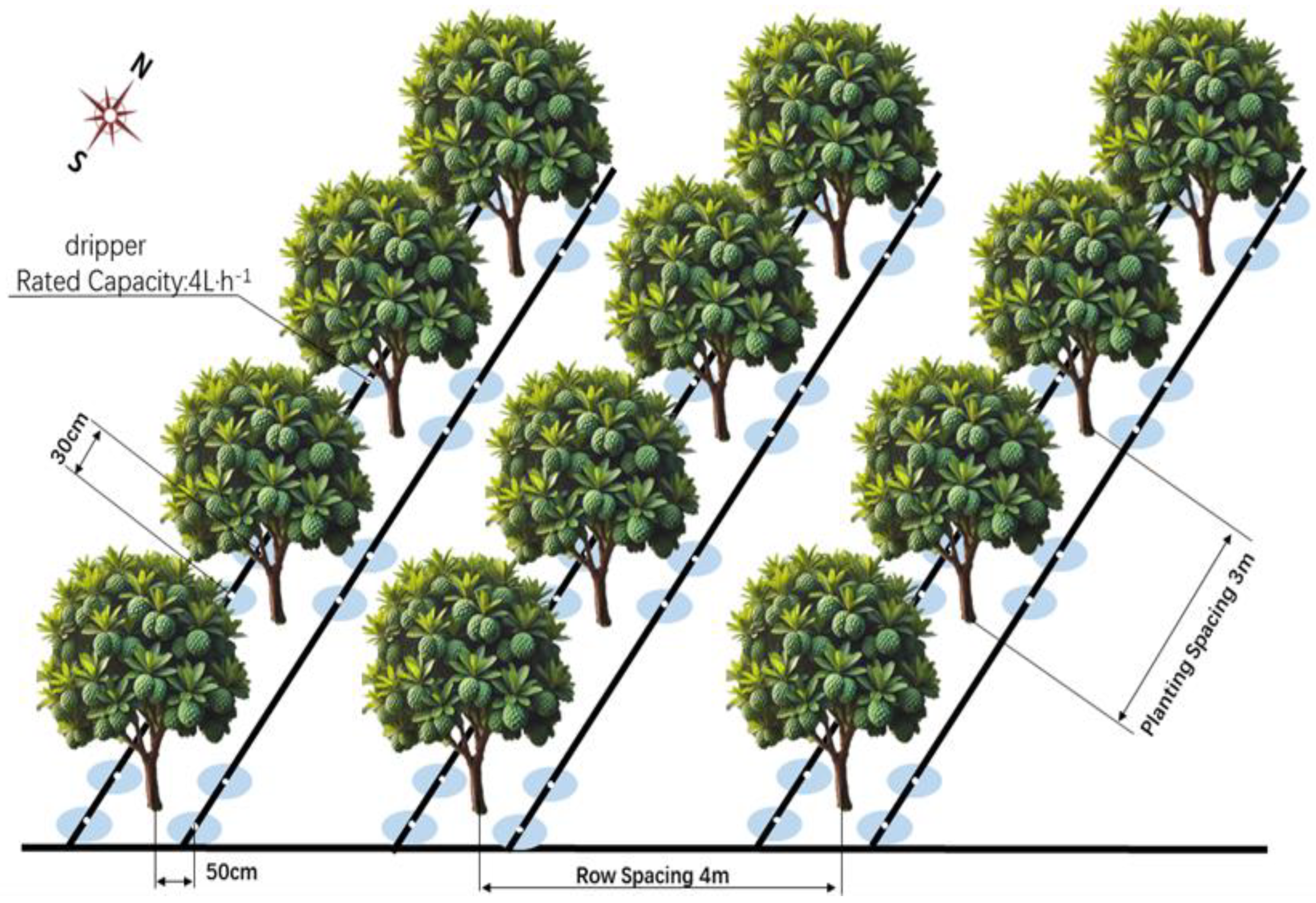
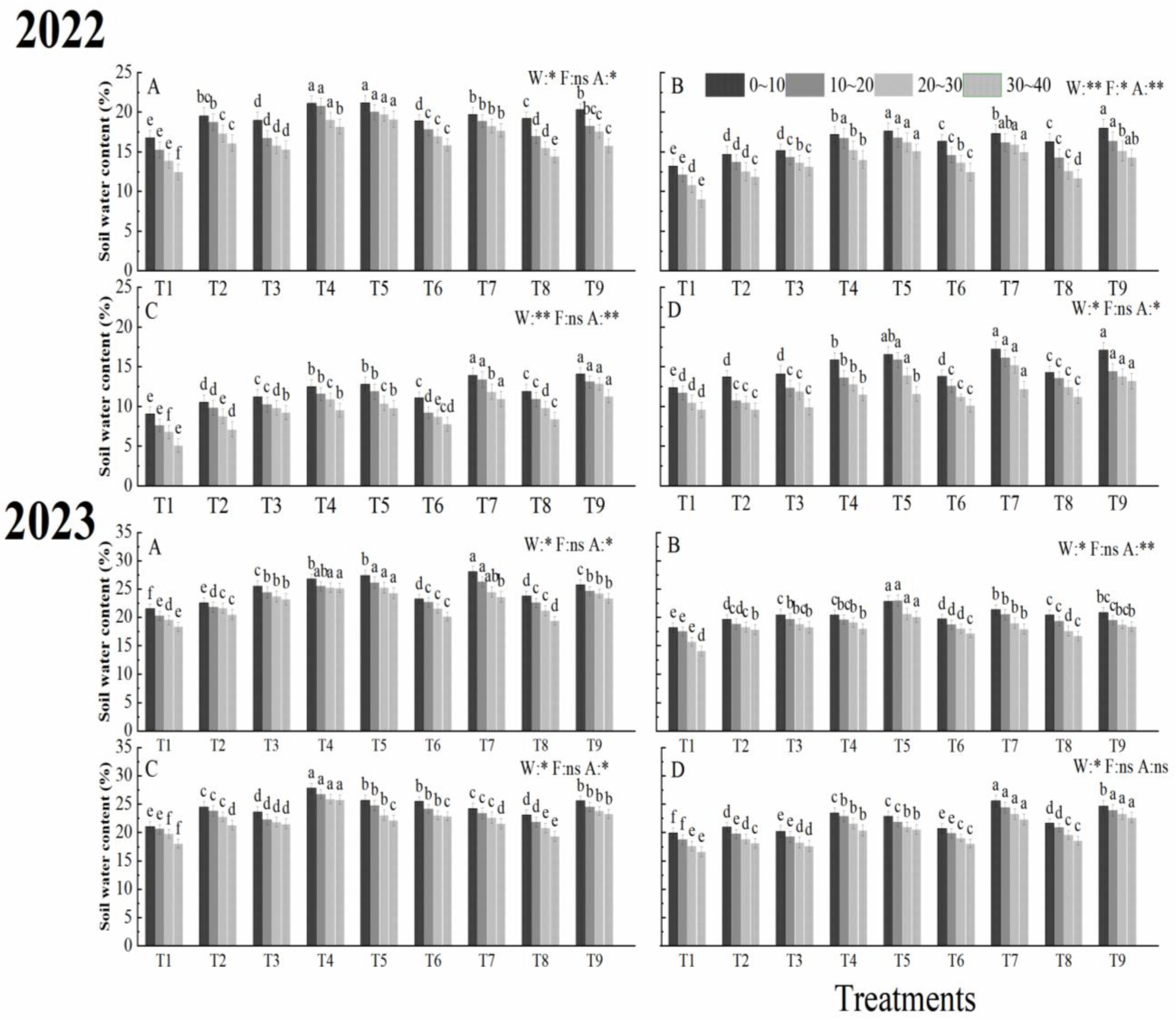
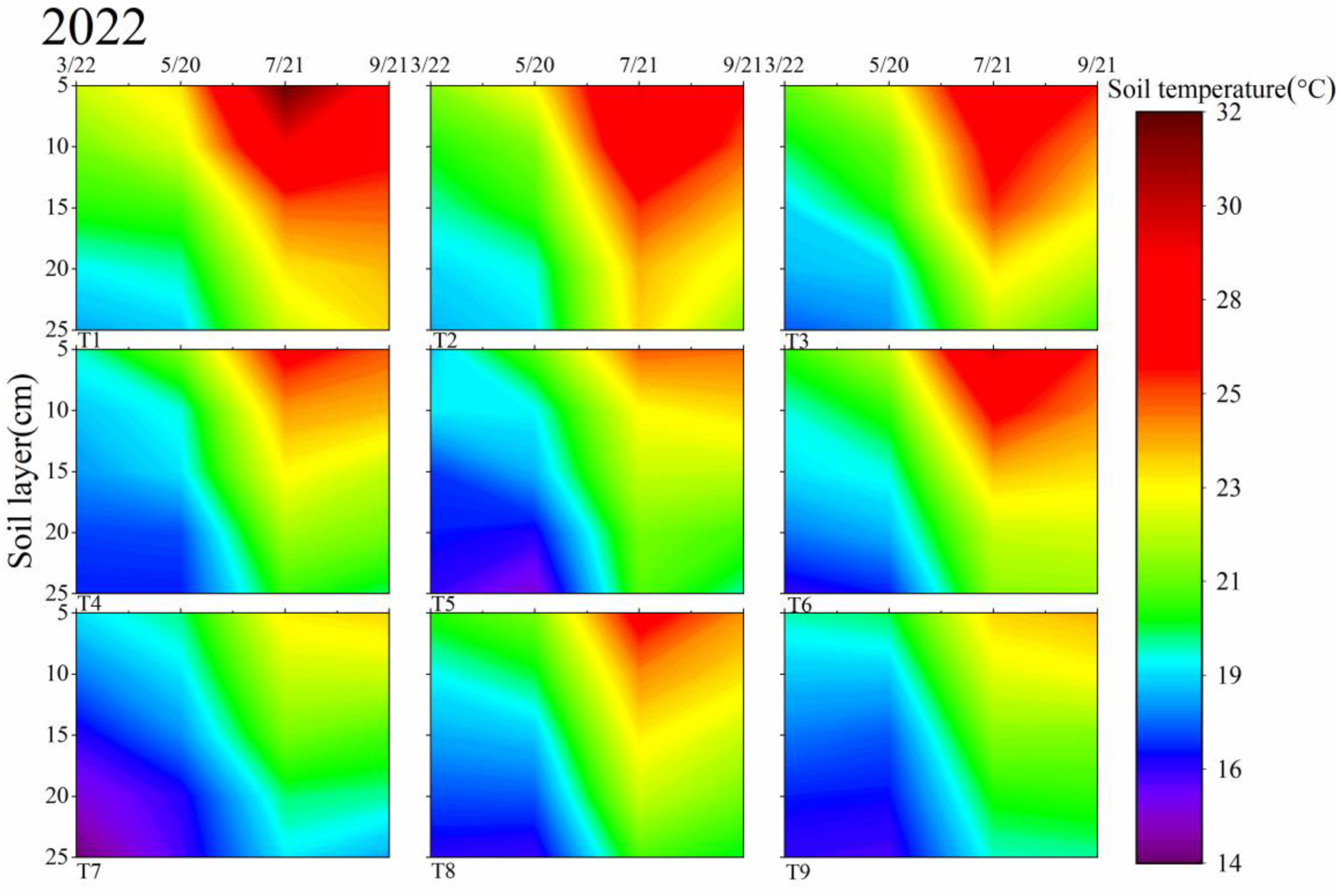

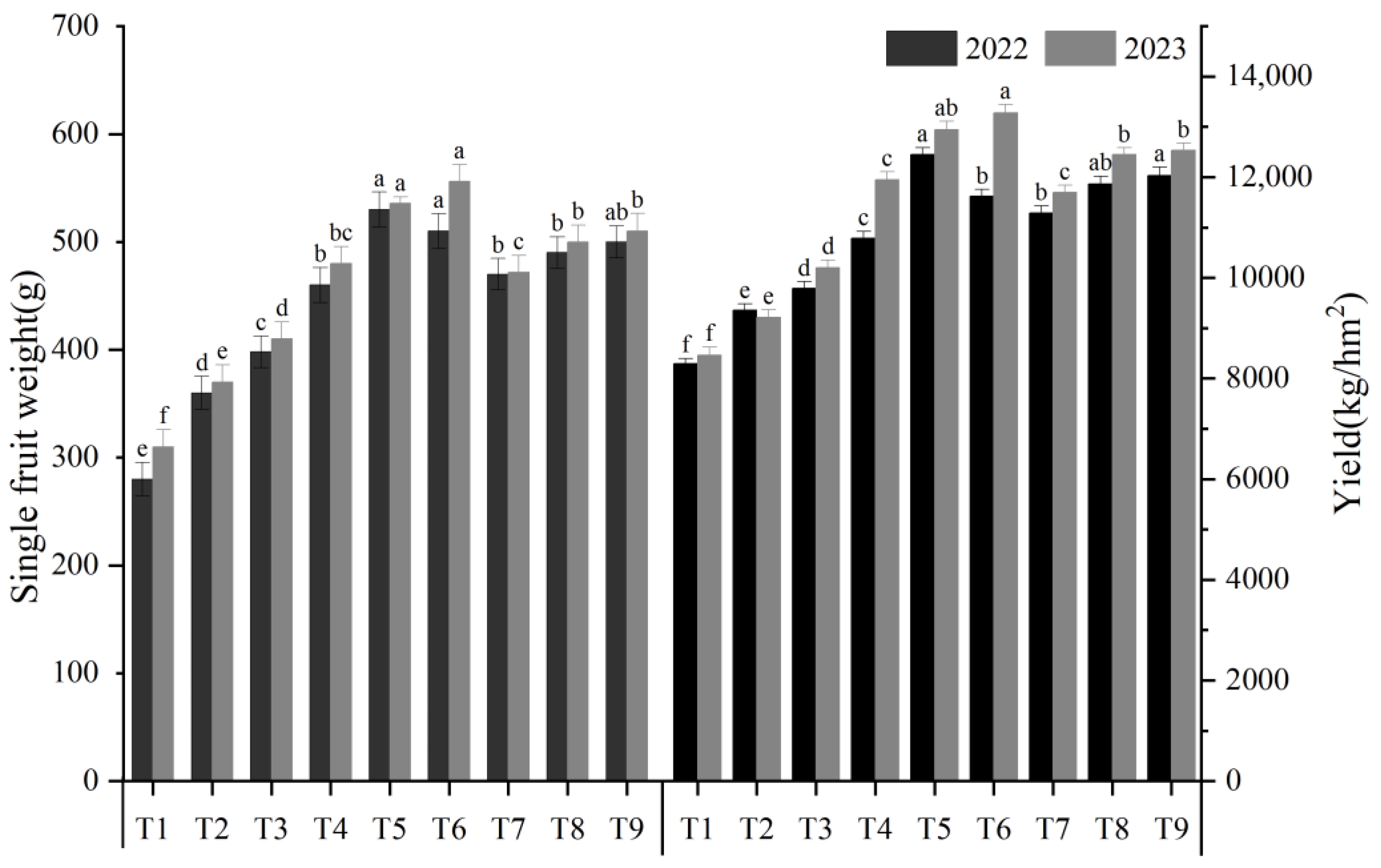
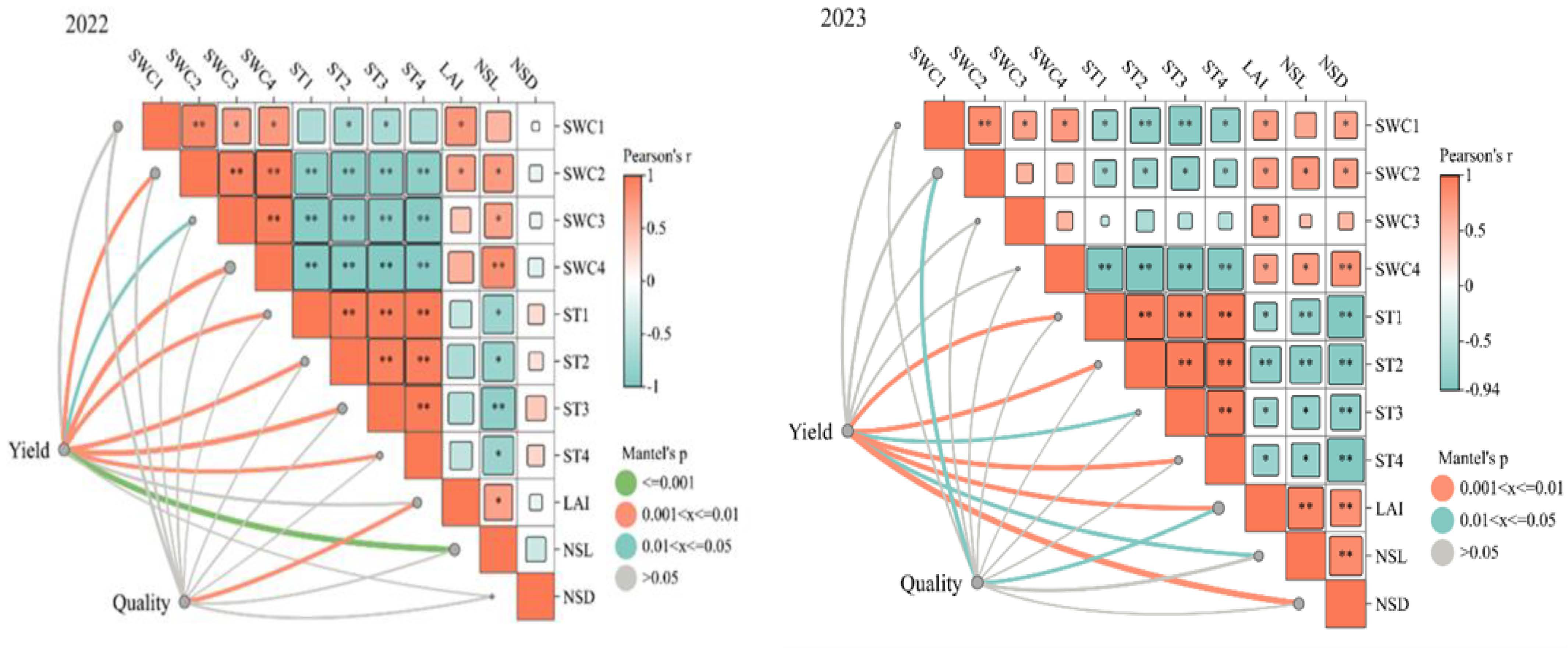
| Treatments | Factors | Treatments | ||
|---|---|---|---|---|
| Irrigation Levels (W) mm | Fertilizer Amount (F) kg·hm−2 | Cover Measures (A) | ||
| T1 | W1 (55%FC) | F1 (1666) | A1 (no cover) | W1F1A1 |
| T2 | W1 (55%FC) | F2 (2083) | A2 (fresh grass cover) | W1F2A2 |
| T3 | W1 (55%FC) | F3 (2500) | A3 (straw cover) | W1F3A3 |
| T4 | W2 (65%FC) | F1 (1666) | A2 (fresh grass cover) | W2F1A2 |
| T5 | W2 (65%FC) | F2 (2083) | A3 (straw cover) | W2F2A3 |
| T6 | W2 (65%FC) | F3 (2500) | A1 (no cover) | W2F3A1 |
| T7 | W3 (75%FC) | F1 (1666) | A3 (straw cover) | W3F1A3 |
| T8 | W3 (75%FC) | F2 (2083) | A1 (no cover) | W3F2A1 |
| T9 | W3 (75%FC) | F3 (2500) | A2 (fresh grass cover) | W3F3A2 |
| Treatments | 2022 | 2023 | ||||
|---|---|---|---|---|---|---|
| New Shoot Length | New Shoot Diameter | LAI | New Shoot Length | New Shoot Diameter | LAI | |
| T1 | 30.43 ± 3.35 cd | 1.15 ± 0.05 abc | 2.23 ± 0.36 a | 34.12 ± 1.56 de | 0.75 ± 0.05 d | 2.53 ± 0.05 d |
| T2 | 30.61 ± 3.55 cd | 1.30 ± 0.03 a | 2.24 ± 0.27 a | 35.36 ± 2.63 d | 0.83 ± 0.07 bc | 2.60 ± 0.05 c |
| T3 | 31.27 ± 2.82 bc | 1.34 ± 0.05 ab | 2.26 ± 0.23 ac | 35.78 ± 3.24 d | 0.87 ± 0.09 bc | 2.62 ± 0.05 c |
| T4 | 35.20 ± 3.28 ab | 1.39 ± 0.03 ab | 2.42 ± 0.09 a | 39.22 ± 2.04 b | 0.92 ± 0.09 b | 2.89 ± 0.09 a |
| T5 | 35.57 ± 2.71 ab | 1.28 ± 0.06 d | 2.40 ± 0.16 a | 46.36 ± 2.45 a | 0.98 ± 0.06 ab | 2.96 ± 0.03 a |
| T6 | 36.33 ± 3.51 a | 1.29 ± 0.08 ab | 2.37 ± 0.2 a | 38.65 ± 2.96 c | 0.94 ± 0.07 b | 2.78 ± 0.04 b |
| T7 | 35.07 ± 2.37 ab | 1.33 ± 0.07 ab | 2.34 ± 0.19 c | 40.23 ± 3.38 b | 0.97 ± 0.06 ab | 2.73 ± 0.03 b |
| T8 | 35.35 ± 2.46 ab | 1.27 ± 0.07 cd | 2.29 ± 0.19 ab | 39.42 ± 2.06 b | 0.95 ± 0.07 b | 2.71 ± 0.06 b |
| T9 | 36.25 ± 2.46 a | 1.26 ± 0.06 bcd | 2.27 ± 0.22 a | 45.21 ± 2.48 a | 1.02 ± 0.06 a | 2.93 ± 0.06 a |
| W | * | ns | * | ** | ** | * |
| F | * | ns | ns | ns | * | ns |
| A | ns | ns | ns | ns | ** | ns |
| Treatment | 2022 | 2023 | ||||||
|---|---|---|---|---|---|---|---|---|
| Soluble Solids (%) | Soluble Sugar (mg·g−1) | Sugar–Acid | Vitamin C (mg100mL−1) | Soluble Solids (%) | Soluble Sugar (mg·g−1) | Sugar–Acid | Vitamin C (mg100mL−1) | |
| T1 | 20.32 ± 0.05 g | 167.56 ± 1.03 e | 66.5 ± 0.05 g | 36.61 ± 0.02 d | 21.12 ± 0.06 fg | 170.74 ± 1.23 f | 67.36 ± 0.07 g | 35.82 ± 0.04 cd |
| T2 | 22.41 ± 0.05 f | 173.89 ± 2.04 c | 67.8 ± 0.04 f | 36.82 ± 0.06 c | 21.91 ± 0.07 f | 176.59 ± 1.14 de | 68.88 ± 0.06 f | 36.30 ± 0.06 c |
| T3 | 23.62 ± 0.06 e | 177.32 ± 1.24 bc | 69.87 ± 0.07 d | 37.24 ± 0.05 ab | 23.12 ± 0.07 d | 179.66 ± 1.09 d | 69.97 ± 0.08 f | 36.85 ± 0.05 bc |
| T4 | 26.58 ± 0.04 c | 182.32 ± 1.21 b | 71.06 ± 0.07 cd | 37.564 ± 0.05 ab | 25.46 ± 0.05 c | 187.65 ± 1.36 b | 72.36 ± 0.07 c | 37.65 ± 0.05 ab |
| T5 | 28.94 ± 0.05 a | 194.69 ± 1.33 a | 73.56 ± 0.55 a | 37.92 ± 0.05 a | 28.76 ± 0.04 a | 195.79 ± 1.44 a | 74.67 ± 1.55 a | 38.23 ± 0.05 a |
| T6 | 27.56 ± 0.04 b | 183.78 ± 1.25 b | 72.49 ± 0.08 b | 37.62 ± 0.04 a | 26.56 ± 0.04 b | 182.58 ± 1.52 c | 73.59 ± 0.08 b | 37.92 ± 0.04 a |
| T7 | 23.46 ± 0.03 e | 174.45 ± 1.56 c | 70.33 ± 0.12 d | 37.11 ± 0.02 bc | 22.96 ± 0.06 e | 176.45 ± 0.09 de | 71.34 ± 0.18 d | 37.24 ± 0.03 b |
| T8 | 25.58 ± 0.07 d | 178.69 ± 1.67 b | 69.96 ± 0.05 d | 37.32 ± 0.04 ab | 24.68 ± 0.07 c | 172.69 ± 0.08 e | 70.23 ± 0.08 e | 37.57 ± 0.04 ab |
| T9 | 22.94 ± 0.05 f | 169.69 ± 1.35 d | 68.77 ± 0.04 e | 36.95 ± 0.04 c | 21.57 ± 0.06 f | 170.69 ± 1.03 f | 71.11 ± 0.07 d | 36.75 ± 0.04 bc |
| W | * | ns | ns | * | * | * | * | * |
| F | ns | ns | ns | ns | * | ns | ns | ns |
| A | ns | ns | ns | ns | ns | * | * | ns |
Disclaimer/Publisher’s Note: The statements, opinions and data contained in all publications are solely those of the individual author(s) and contributor(s) and not of MDPI and/or the editor(s). MDPI and/or the editor(s) disclaim responsibility for any injury to people or property resulting from any ideas, methods, instructions or products referred to in the content. |
© 2024 by the authors. Licensee MDPI, Basel, Switzerland. This article is an open access article distributed under the terms and conditions of the Creative Commons Attribution (CC BY) license (https://creativecommons.org/licenses/by/4.0/).
Share and Cite
Wang, W.; Bai, T.; Liu, X. Effects of Water, Fertilizer and Heat Coupling on Soil Hydrothermal Conditions and Yield and Quality of Annona squamosa. Agronomy 2024, 14, 2189. https://doi.org/10.3390/agronomy14102189
Wang W, Bai T, Liu X. Effects of Water, Fertilizer and Heat Coupling on Soil Hydrothermal Conditions and Yield and Quality of Annona squamosa. Agronomy. 2024; 14(10):2189. https://doi.org/10.3390/agronomy14102189
Chicago/Turabian StyleWang, Weihua, Ting Bai, and Xingwen Liu. 2024. "Effects of Water, Fertilizer and Heat Coupling on Soil Hydrothermal Conditions and Yield and Quality of Annona squamosa" Agronomy 14, no. 10: 2189. https://doi.org/10.3390/agronomy14102189







